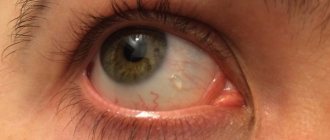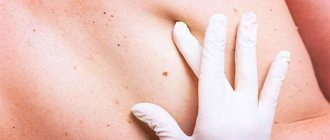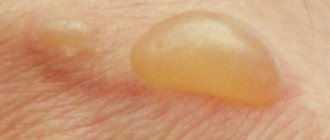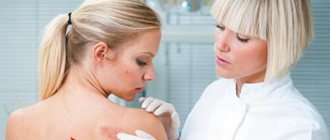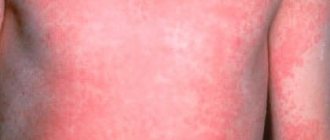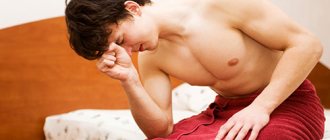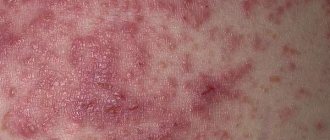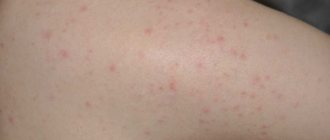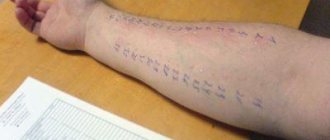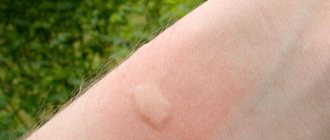Why do watery blisters appear on the legs?
The symptoms that accompany blisters on the soles of the feet, fingers, and between them vary. If you know what caused these blisters on your feet, then use the appropriate treatment for the problem. What are the causes of blisters on the feet:
- Fungal infection of the feet. Mycosis can be contracted in the pool, sauna, gym or on the beach, so having slippers/replacement shoes in such places is mandatory.
- Allergic reaction and other skin diseases. New shoes, a specific polish, spray, cream or any other product can cause blisters on the soles of your feet.
- Insect bites.
- Sun or household burns.
- Uncomfortable, too-tight shoes cause callus blisters.
To the doctor?
It is also worth knowing at what point it is necessary to urgently consult a specialist, and what situation allows for independent treatment. The following reasons will be the determining factor for visiting a doctor:
How to treat watery blisters on the soles of your feet
Blisters on your feet itch, but you don’t know what to do with them? Do not pierce them under any circumstances! This risks the fact that you may catch an infection and complicate the treatment process. If blisters appear on your foot and itch, you should definitely consult a dermatologist to understand the cause. After treatment, do not forget about important rules that will protect you from the recurrence of blisters on your feet:
- Shoes should be “breathable”, made from natural materials, and always comfortable.
- Do not walk barefoot on the beach or in the pool.
- Protect your feet with special clothing and shoes if you are in an environment where chemicals are used.
- Try to avoid products and household chemicals that are allergens for you.
- Choose a trusted pedicurist who properly and thoroughly processes the tools to prevent infection.
- UV protection should be used on exposed areas of the body.
Fungal water blisters on feet
Mycosis (fungus) can be contracted by anyone. If you are in public places (swimming pool, sauna, etc.) without shoes, you can easily become infected. The development of the fungus occurs slowly, the manifestation of mycosis in the form of blisters appears on the feet, fingers, between the toes, and heels.
The initial stage may go unnoticed by the patient, then reddish spots and a rash appear. Further, as a result of neglect, there are bubbly blisters filled with liquid that itch severely and burst. In such situations, the dermatologist prescribes antifungal medications that kill the spores that appear and prevent them from spreading. The forms of release of such drugs are: tablets, capsules, gel, cream, ointment or spray. Treatment for blisters caused by a fungal infection takes a long time - from 2 months to a year.
- The lymph node under the arm is inflamed: what to do and how to treat it
- What is fibrofatty involution of the mammary glands?
- Homemade Philadelphia cheese
Allergic water blisters on feet
Blisters on the feet of a child or adult can also appear as an allergic reaction. In such cases, blisters “float” on the feet and between the toes. The main signs are redness of the skin, confluence of blisters and severe itching. To protect your feet and the body as a whole from allergies, the doctor will prescribe antihistamines: foot ointments, tablets, injections.
Callus blisters on the soles of the feet
Such formations can be cured on their own. They appear on the bones, heels, and toes due to uncomfortable shoes. Small blisters should be covered with antibacterial patches. Try to protect skin areas from re-injury. If the callus is large and the blister is in the way, then it can be carefully pierced with a sterile needle, having first disinfected the puncture site.
To disinfect a painful blister, use iodine, brilliant green, and peroxide. To treat a needle, you need to burn it over a fire, and then dip it in alcohol, iodine or furatsilin solution for a minute. You need to puncture a blister by inserting a needle into the blister parallel, but not perpendicular. After the puncture, use gauze or a bandage to carefully free the callus from the internal fluid, then treat it with antibiotic ointment. Cover the top of the wound with a plaster so as not to injure the delicate area of the skin.
Blisters on the soles of the feet from external influences
What to do if the cause of unpleasant bubbles is external irritants:
- For sunburn. Small water pimples on the legs and throughout the body may appear after long walks or exposure to direct sunlight. Pimples, large and small, from the burn not only itch, but also hurt. You can't pierce them! Use anti-burn products that reduce pain, prevent infection from developing and heal wounds.
- Insect bites. Such blisters threaten not only redness, itching, but also swelling of the skin. To eliminate these symptoms, you will need antihistamines for oral and external use. You should not scratch the rash, otherwise there is a risk of complicating the treatment and health of the skin.
Prevention of dropsy
Elderly people need to follow some recommendations so as not to provoke the appearance of dropsy. In particular this applies to:
- Shoes. Properly fitting shoes prevent the risk of swelling in older people.
- Limiting salt and water. Edema develops when the water balance in the body is disturbed. Salt causes water retention in the body. A salt-free diet for older people can regulate water balance.
- Lack of moderate physical activity on the body. Often, a “lazy” lifestyle can also cause the development of many diseases, which are manifested by swelling of the lower extremities. Therefore, it is important for older people to take daily walks and various physical exercises.
- Taking medications. There are drugs that not only relieve dropsy, but also, on the contrary, contribute to its appearance. If such symptoms are detected, elderly patients should consult a doctor so as not to worsen their condition. The doctor may replace the drug with a similar remedy.
We recommend additional reading: What is serozometra or fluid in the uterus in old age
If you prevent edema in old age and do it more than once, but daily and often, you can prevent the development of diseases.
Treatment methods
Subcutaneous water blisters on the feet can be a manifestation of many diseases. Before you begin to treat the rash, it is necessary to establish an accurate diagnosis. A dermatologist will be able to differentiate the disease and prescribe effective therapy.
| Treatment method | Drugs |
| Ointments | If a foot blister is caused by an allergy, the allergen or chemical agent must be eliminated. |
To reduce itching, use: Akriderm Genta, Gistan, Levosin, Olidel, Fucidin, Fenistil, Eplan, Elokom, others.
For viral pathogenesis, ointments are indicated: Acyclovir, Viferon, Zovirax, Tsindol.
For scabies, use Zinc ointment, Spregal, Medifox.
For burns: Levomekol, Panthenol, Bepanten, Vishnevsky balm, Rescuer.
For hyperhidrosis: Teymurov paste, Zinc ointment, Cutivate, Formagel. For eczema: Losterin, Afloderm, Advantan, Cinacort, Sinaflan, Sinalar.
Ointments for fungus: Zalain, Mikozan, Lamisil, Clotrimazole, Mycozolin, Exoderil, Terbinafine, Nizoral, Bufinal.
For allergies, pemphigus, chickenpox, antihistamines are used: Loratadine, Zyrtec, Dimetindene, Fenistil, Cetrin, Cetirizine, Claritin.
For chickenpox and viral pemphigus, take antiviral medications: Acyclovir, Cycloferon, Viferon, Kipferon, Isoprinosine, Arbidol, Valtrex.
Tablets for mycoses: Terbinafine (can be purchased in the form of a spray, cream), Lamisil, Itraconazole, Candide, Mycozoral (available in the form of an ointment), Griseofulvin, Fungoterbin (available in the form of a spray, cream).
For excessive sweating of the feet (hyperhidrosis), it is recommended to treat the feet with Formidron.
Blisters that appear on the soles of the feet are treated with hyperhidrosis with decoctions of oak bark, tea infusions, baths with soda and salt (for 3 liters of warm water, 2 tablespoons of soda, 1 tablespoon of salt).
Wipe the skin with a mixture of table vinegar and alcohol (1:1). Apple cider vinegar is used externally.
Erysipelas is relieved with bee products (honey and propolis). Honey is melted in a water bath, mixed with dry plantain, ground into powder, and applied to the sore spot.
Allergy
A watery rash often appears as a protective reaction of the body to a certain irritant. In addition to the rash, the person also suffers from unpleasant itching. Since there is now a wide selection of antiallergic drugs on pharmacy shelves, many people who are faced with a problem try to deal with it on their own at first, without turning to a specialist.
But such actions often remain ineffective. Without identifying the allergen with a view to its subsequent elimination, the patient’s condition will constantly worsen at the first contact with it. Allergens can include food, skin care products and household chemicals.
Possible complications
You should not ignore the problem or self-medicate; even ordinary acne can cause serious consequences. Acne that appears on the heels can trigger the onset of such a serious disease as heel fasciitis. With rashes on the extremities, there is a risk of infection, which can lead to gangrene, and in advanced cases, amputation. Terrible complications can be avoided if you seek medical help in a timely manner and follow preventive measures:
- monitor hand and foot hygiene, use antibacterial soap after visiting public places;
- carefully care for the skin of your feet using moisturizers;
- do not walk barefoot in the sauna or swimming pool;
- lead a healthy lifestyle, give up bad habits;
- eat a nutritious, varied diet, including vitamins and minerals in the diet;
- avoid stress and overexertion.
Skin defects cause aesthetic discomfort and unbearable pain, which changes the usual way of life. You should be attentive to any changes in the body in order to quickly get rid of a delicate problem. Timely medical care and medications will help restore health and beauty to the skin without relapses or negative consequences.
What is a disease
Transparent blisters on the toes are a kind of skin formation that is filled with a clear or slightly cloudy liquid. What is this small bag filled with? Exudate or effusion is liquid that accumulates in tissues or cavities in the presence of an inflammatory process in the body. This is a kind of protective mechanism of the body.
The color and size of the exudate depend directly on the cause of the bubbles. The shape of the formations can also be varied and not always round. Traditionally, blisters are localized on the delicate skin between the toes. They do not pose a direct threat to human health, but can cause inconvenience, irritate the skin and even cause pain.
If such a cosmetic flaw occurs in a representative of the fair sex, then psychological discomfort also occurs. Many girls even try to open the formations to remove fluid and make the bubbles less noticeable. Of course, this is not worth doing, since the resulting wound will cause even more pain, and if disinfection is insufficient, pus and inflammation may appear.
If such blisters appear in a child, then parents should carefully ensure that the child does not damage the skin while playing. If the baby is very small and there is no way yet to explain to him why the bags should not be torn or scratched, you should try putting the child in cotton socks to protect the bubbles from mechanical stress.
If possible, the open wound at the site of the damaged dropsy should be covered with a plaster. It must be regularly cleaned of contaminants and treated with hydrogen peroxide. The “Rescuer” balm will help speed up the healing process and slightly reduce pain.
Causes
It’s worth reassuring us right away that blisters on the soles of your feet are not always a symptom of any disease. For your attention, all the reasons for the appearance of this disease:
- Allergic reaction. A fairly common occurrence, especially among lovers of synthetic socks and shoes made of low-quality materials. It can manifest itself not only in the form of water blisters on the legs, but also swelling, redness and severe itching. Ignoring the problem leads to severe scratching and open wounds, which can become an “entry gate” for infection. In some cases, the symptoms manifest themselves so clearly that the patient cannot even step on his foot due to severe pain.
- Hyperhidrosis. A very unpleasant disease, the main symptom of which is excessive sweating. Very often it appears in the foot area and can be accompanied by small watery blisters, scratching, burning and severe itching. It occurs predominantly in men aged 20-35 years. The reason may lie both in endocrine disorders and in the chemical composition of sweat.
- Mycosis of the feet. Here the reason may lie in one of the fungal diseases, combined into one group due to the similarity of symptoms. The appearance of blisters on the feet is characteristic of the dyshidrotic form of athlete's foot, which can also be localized in the interdigital spaces and on the soles of the feet. The blisters are usually filled with serous, cloudy or purulent fluid. As the process progresses, they burst, leaving erosion in their place. This form of epidermophytosis is very difficult to treat and is prone to constant relapses, especially in spring and summer. Less commonly, such symptoms can be observed when the feet are affected by rubromycosis.
- Scabies. The most common cause of blisters on ankles in children. The blisters are usually filled with serous fluid, are painful and are always accompanied by severe itching. In their place, bloody crusts the size of a pinhead subsequently form. In adults, rashes are most often localized on the hands, mammary glands, genital area and armpits.
Very rarely, psoriasis may appear in the form of blisters on the feet at the initial stage. As the process progresses, the skin in this area becomes rougher, transforming into a “plaque.” It can also be observed with dyshidrotic eczema, which is almost always localized on the feet and palms at the same time.
Fungal disease
Some varieties of fungi are able to remain active and viable for an extended period of time, spreading infection to various parts of the lower extremities.
Since the affected areas become very itchy, the itching can cause a person great discomfort. The skin often begins to peel and crust over.
Traditional medicine against blisters
Current medicine emerged from the correct use of medicinal plants, so folk remedies should not be dismissed. But also blindly follow all recommendations. The best option is to make a selection of suitable recipes and consult a doctor about the possibility of using them.
Let's consider several options for such recipes:
- Compresses from a decoction of the string to speed up the healing of the effects of blisters. Preparing is extremely simple. Steam four tablespoons in a glass of boiling water in a water bath for half an hour. Cool and apply to the affected skin area.
- A basin half filled with cold water will help relieve itching and inflammation around it. Add ice and five drops of geranium and/or tea tree oil to this volume. 20 minutes in such a bath works wonders.
- Egg whites and celandine decoction will help with burns. First you need to prepare a decoction of celandine. One tablespoon of it is silted with a glass of water and simmered for half an hour, then infused for 3 hours. The affected area of skin should be lubricated with protein and left for an hour. Afterwards, cover it with a compress with a decoction of celandine for 40 minutes.
It is important to correctly follow the proportions and recipes given in the recipes. And once again, remember to consult a professional doctor before using traditional recipes.
Thus, when blisters appear on your feet that are very itchy and other symptoms of skin problems, it is better not to hesitate. It’s even better to carefully monitor your feet, avoid wearing inappropriate shoes, maintain hygiene and periodically carry out preventive maintenance.
Attend professional medical pedicure sessions, for example. This is much simpler and more effective than treating blisters in a child using a photo with explanations.
Tags: allergies, dropsy, blisters, ankle, shin, fungus, diabetes, finger, foot, feet, feet About the author: Andrey Stepanovich
« Previous entry
First actions upon appearance
It is not recommended to pierce them to avoid infection.
If the formation is small and it is possible to preserve its integrity by protecting its area from the shoe material, then it is better to wait for it to pass naturally.
When the bubble is of impressive size, it most often causes inconvenience, and it will most likely not be possible to save it without injuring it.
In this case, it is more advisable to pierce before it collapses on its own. If this happens, dirt may get into it and it will become inflamed.
Before the procedure, wash your feet and hands thoroughly. Prepare a needle that has been disinfected with alcohol or burned. Wipe the blister with alcohol and make a small puncture at the base, closer to the intact skin. Squeeze out all the liquid from the bubble.
Press the skin against the wound, it will help protect the inner surface from infection . Cover the sore spot with adhesive tape. If the blister area is large, apply a gauze bandage.
Change the bandage daily, and if possible twice a day, to eliminate the slightest possibility of the blister inside getting wet.
If possible, the bandage should be removed: at night or when you are at home and you can walk without shoes. This way healing will happen faster as the skin will dry out. A completely dry and well-protected blister from infection will soon dry out and fall off on its own. Underneath you will find completely healthy skin.
First aid
If a person develops blisters on their toes or other areas, they should be kept intact. It is prohibited to remove them mechanically, as you can accidentally introduce an infection, and this, in turn, will aggravate the situation and provoke an inflammatory process.
To prevent the tumor from bursting, contact with shoes or clothing should be avoided. If the watery blisters on the legs have become impressive in size, then they can be pierced. However, before doing this, you should wash your hands well and disinfect the tool. Often, a regular sewing needle, which has been previously soaked in alcohol, is used for removal.
Please note that punctures should be done where there are areas of healthy skin nearby . After the puncture, press on the bottle so that all excess liquid comes out. It is impossible to remove the skin that covered the blister, since in this case the wound will take a very long time to heal.
To make the wound heal faster, you should use special healing ointments, for example, Levomekol. The top of the wound should be sealed with a bactericidal plaster; it should be changed as often as possible to avoid the development of an inflammatory process.
